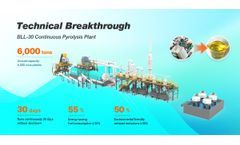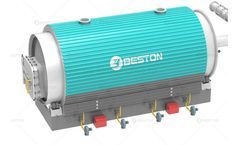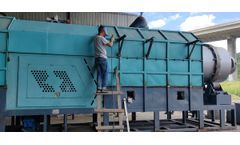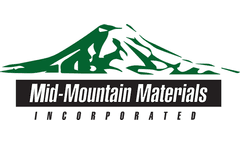Condensible Gas Articles & Analysis
33 articles found
Below are the three key technological breakthroughs that set this equipment apart: 1. Efficient Oil-Gas Condensation and Anti-Polymerization Technology This technology uses a direct spray mixing method to quickly reduce the oil and gas temperatures, improving the condensation efficiency. ...
Branch in Bialystok, boiler K6, Poland In 2014-15, Radscan provided flue gas condensation and condensate purification to boiler K6 at ENEA’s CHP plant in Bialystok. ...
The inlet door has to be tightly sealed to make certain that no gas can leak out. - Pyrolysis Charcoal, fuel gas, or wood is utilized to deliver heat for the pyrolysis reactor. The reactor warms up gradually as soon as they have reached a particular temperature, oil gas is generated. - Condensing The ...
This step involves securing the pyrolysis reactor, condensation system, gas cleaning system, and auxiliary equipment. 3. Installation and Assembly Once the equipment is on-site, commence the installation process. ...
Step 3: Separation in the By-Products If the temperature reaches 100°C (the very best output rate interval is 250-280°C), the oil gas will likely be emitted. The heavy oil gas separated from the manifold should certainly liquefy and fall into the heavy oil tank. The lighter gas will likely then rise to the oil condensers, ...
Step 3: Separation of the By-Products Once the temperature reaches 100°C (the most notable output rate interval is 250-280°C), the oil gas will likely be emitted. The heavy oil gas separated with the manifold should certainly liquefy and fall directly into the heavy oil tank. The lighter gas will likely rise towards the oil ...
Pyrolysis plant principle The principle of this sort of plant is as follows: the reactor heats the raw materials to produce oil gas. The oil gas then enters into a condenser that converts the gas into liquid oil. ...
After the carbonization process, the raw material is discharged automatically. The produced combustible gas is reused and may substitute LPG for heating the reactor, which saves energy costs. The charcoal produced is referred to as wood charcoal.Combustible Gas Employed to Heat DryerCharcoal making machines are generally provided with different parts. These parts ...
We are thrilled to present a remarkable case study that showcases the power of SICK Sensor Intelligence in revolutionizing emissions monitoring and energy production. Discover how Kuopion Energia, a leading energy company in Finland, leveraged our MCS200HW multi-component analyzer system to achieve unparalleled efficiency, lower emissions, and reliable supply of heat and electricity ...
The heavier liquified oil drops into a tank below as the lighter gas rises up into the condensation tank above. Stage 4: Purification The non-condensable gas that’s produced within the pyrolysis process is going to be purified. ...
The primary portion of the process is definitely the reactor, which heats up the tyres through a mix of fuel oil, LPG, or gas. During the heating process, the reactor rotates 360 degrees. For that reason, the tyres commence to crack and emit oil gas. Once the oil gas reaches a certain temperature, it is condensed and discharged, ...
This step is essential to converting the waste materials into combustible fuel. The reactor releases oil gas when the chamber reaches 100o C. Soon, the heavy oil gas separates by manifold and enters the condenser. Here the oil gas liquefies and drops down into a huge oil tank. However, the lighter gas rises up in ...
Step Three: Separation of the By-Products When the temperature reaches 100°C (the best output rate interval is 250-280°C), the oil gas will be emitted. The heavy oil gas separated through the manifold should certainly liquefy and fall into the heavy oil tank. The lighter gas will likely rise on the oil condensers, where ...
A recooling plant is also available for emergencies. A gas condensing boiler serves as a second heat source to secure the heat demand. ...
The inlet door has to be tightly sealed to ensure that no gas can leak out.- PyrolysisCharcoal, fuel gas, or wood can be used to provide heat for the pyrolysis reactor. The reactor gets hotter gradually and as soon as it offers reached a unique temperature, oil gas is generated.- CondensingThe condensing-system receives oil ...
Several of that will be by means of a gas that can condensate right into a liquid. This will be oils that will have combustible properties. ...
The desirable temperature is thirty degrees, and then on, you have the collection and storage of your charcoal.The combustible gas, alternatively, undergoes a spray dedusting system. Here it gets purified and elimination of any traces of sulfur, which could have negative effects when directly subjected to the climate. Furthermore, there may be processing for harvesting opposite ...
The desirable temperature is thirty degrees, and later on, there is a collection and storage in the charcoal.The combustible gas, on the other hand, goes through a spray dedusting system. Here it gets purified and removing of any traces of sulfur, which can have side effects when directly subjected to the atmosphere. Furthermore, there may be processing for harvesting opposite ...
A steam trap is a type of valve that filters out condensate and non-condensable gases from pipework without losing steam. The condensate in a typical pipe system may be condensed steam, while a non-condensable gas may be as simple as air. ...
26 MWh Kaunas, Lithuania 2018 March 24 Main equipment Fuel supply system - overground warehouse with moving platforms Fuel combustion system - Saxlund combustion grate with water-tube steam boiler Additional heat generation equipment - flue gas condensing economizer (FGCE) Flue gas cleaning system - multicyclones Purpose of ...












